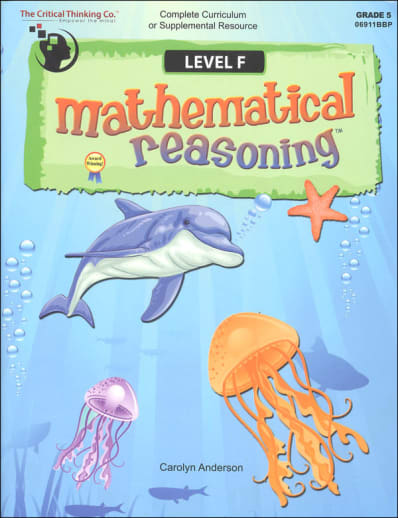Presenting math in a fun, colorful, and engaging manner, Mathematical Reasoning Level F for 5th grade students will correlate to NCTM standards and help your students feel confident as they explore strategies to solve math problems. Primary skills practice focuses on whole number operations, fractions, and decimals. Teaching notes can be found on the bottom of certain pages to further guide instruction and provide additional resources like the Balance Benders series, Math Analogies, or Cranium Crackers. Daily lesson time varies, as parents are encouraged to let their child’s attention span guide what is completed. The top of each worksheet identifies the concept/skill being learned, which is a helpful guide for parents. Pages are perforated and can be reproduced for family use. Answers are provided at the back of the book for grading or self-checking. 440 pgs., paperback. ~Rebecca
Mathematical Reasoning Level F (Gr. 5)
Product Overview
- Suitable as a grade-level math curriculum or as a great critical thinking supplement to any grade-level math program
- Focusing on students’ ability to solve problems mathematically and develop critical thinking skills
- Wonderful option for independent learners!
Description
CONTENTS
- Addends
- Addition
- Age
- Analyze Data
- Angles
- Area
- Bar Graph
- Calendar
- Capacity
- Characteristics
- Circle Graphs
- Coins
- Congruence
- Coordinates
- Count
- Data Analysis
- Data Collection
- Decimals
- Division
- Equations
- Equivalence
- Estimate
- Expanded Notation
- Fractions
- Graphs
- Inequalities
- Language
- Length
- Match
- Mean
- Median
- Mode
- Money
- Multiplication
- Negative Numbers
- Number Lines
- Odd/Even
- Order
- Parallel
- Patterns
- Perimeter
- Perpendicular
- Place Value
- Prediction
- Prime/composite
- Probability
- Properties
- Real World Problems
- Reflection/Translation/Rotation
- Regrouping
- Rounding
- Rulers
- Shapes
- Subtraction
- Survey
- Symmetry
- Tables
- Temperature
- Time
- Variables
- Weight
- Whole Numbers
- Word Problems
A grade-level curriculum and supplement in one activity book approach! The Mathematical Reasoning series is a colorful and engaging worktext for students as young as 3 up through 9th grade students. At such an early age, mathematical reasoning begins with simple activities such as distinguishing between even or odd amounts and learning the ordinal numbers. This series is correlated to the NCTM standards, and each level will teach skills in number and operations, algebra, geometry, measurement, and data analysis. Accordingly, each level incorporates topics such as patterns, number lines, graphs, fractions, probability, and problem-solving, as well as basic math operation skills. The authors suggest working through these activity books page-by-page. The content spirals, which gives your child time to "digest" new concepts before moving on to more complex material. The full-color activity sheets should especially appeal to the younger student. Not only are the illustrations eye-catching, but they do an excellent job of demonstrating mathematical representations and relationships.
Although manipulatives are not required, a link to a virtual
manipulative website is provided in case additional concrete-level
reinforcement is needed. A wide variety of exercises and activities are
utilized to keep your child both interested and motivated. The goal is to move
students from a concrete understanding of math to a more abstract knowledge.
This is implemented by following these math stages: concrete, semi-concrete,
semi-abstract, and abstract. This cycle repeats each time a new skill is introduced.
The series incorporates discussion-based problem-solving to prepare students for mathematical reasoning required for upper-level math. Worksheets are reproducible in the family setting and answers are provided at the back for Levels B–Geometry. Work through from cover-to-cover as your math curriculum or introduce specific worksheets to strengthen skills needed as a supplement. ~Rebecca
| Product Format: | Paperback Book |
|---|---|
| Grade: | 5 |
| Brand: | Critical Thinking Company |
| ISBN: | 9781601442666 |
| Length in Inches: | 11 |
| Width in Inches: | 8.5 |
| Height in Inches: | 1.125 |
| Weight in Pounds: | 3 |

